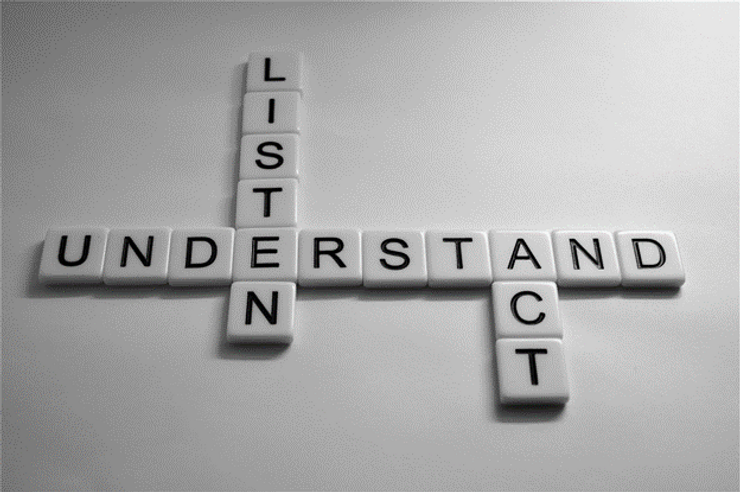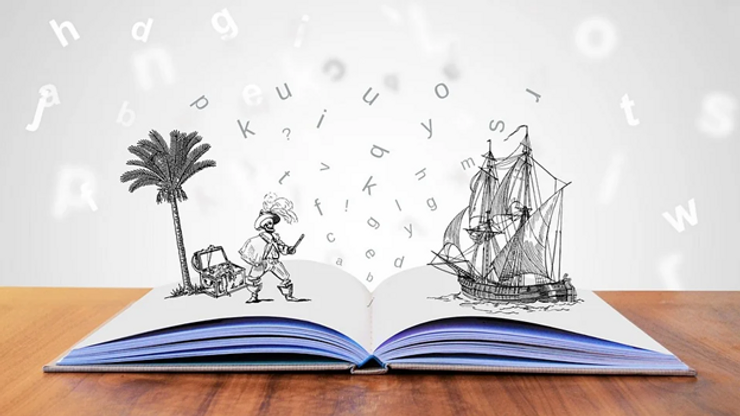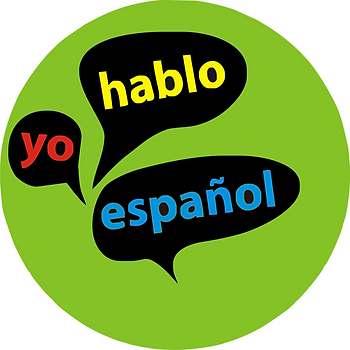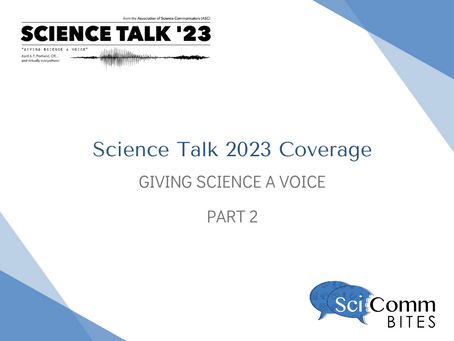Science Talk 2023 Coverage Part 2
Why I chose to attend Science Talk (SciTalk): As an early career science communicator, I was excited to participate in SciTalk 2023 to connect with other science communicators and learn more about successful science communication projects and techniques.
Communicating Science to Science Skeptics
Are you looking to engage science skeptics with your work? Are you curious about what techniques work best to communicate and collaborate with this group?
Natalie Mastick, Kevin Bishop, Saumya Jani, and Miranda Mudge from the University of Washington’s Engage program tackled these questions during their workshop, to help bridge gaps between science and science skeptics.
Mastick, Bishop, Jani, and Mudge had three key takeaways:
- Practice distillation and storytelling
- Listen and respond with warmth
- Be prepared
Practice distillation and storytelling
While knowing your message and your audience is important to communication, understanding how to craft your message is essential. This means avoiding jargon, focusing on the highlights of your story, and connecting with your audience.
Contrary to the existing notion of having to ‘dumb down’ your communication efforts to engage skeptics, distillation refers to making a concept accessible by focusing on the relevant facts and only including what is needed. Mastick, Bishop, Jani, and Mudge recommend practicing distillation by thinking about scicomm as an elevator pitch. If you only had thirty seconds to communicate your work, what would you say? What is relevant to your audience? What is your hook? What is your story?
Having an answer to these questions is not only helpful in distilling your pitch, but it can also help you craft a compelling story to help you connect with your audience.
Listen and respond with warmth

Finding common ground with science skeptics can be difficult. And while this can be frustrating, it is important that we not respond with frustration when faced with difficult or, at times, ridiculous questions.
Listening, without the intent of winning an argument, is a way to help you better understand your audience. This can help you focus your messaging, understand what your audience’s real concerns are, and offer relevant explanations. Mastick, Bishop, Jani, and Mudge encourage scicommers to ask follow up questions, instead of jumping into correcting or dismissing incorrect claims.
Listening and asking follow up questions can also help you identify a common ground and values that you might share with skeptics. Leading with these values and commonalities helps you respond with warmth and build trust.
Be prepared
While this might seem like an obvious takeaway, being prepared and ‘knowing your stuff’ is important when dealing with science skeptics. Understanding common myths, your audience’s information sources, and their common concerns will help you feel more comfortable and be prepared. It will also help you steer away from frustration and keep a composed face when faced with unexpected or difficult interactions.
Final Thoughts
Communicating science to science skeptics can be both professionally and personally challenging. During their workshop, Mastick, Bishop, Jani, and Mudge identified techniques to help us address these challenges to successfully bridge gaps between science and science skeptics. Keeping these techniques in mind when we are faced with difficult situations will not only help us be more efficient science communicators, but will also help us keep our cool and engage skeptics with more empathy.
Oops, we’re epidemiologists in a pandemic: lessons learned by drinking from the firehose
The COVID-19 pandemic was a true test for many science communicators. Finding ways to communicate timely, life saving information amidst uncertainty is no easy feat. In this panel, Katelyn Jetelina, Katrine Wallace, and Jessica Malaty Rivera, with moderator Malia Jones, discuss how they stumbled into science communication during a public health crisis and what lessons they carry with them.
Your Local Epidemiologist
Your Local Epidemiologist is a newsletter that provides updated, timely, and accessible public health information to the local, national, and international community. Epidemiologist Dr. Katelyn Jetelina started this newsletter in March 2020 to keep her students, faculty, and staff informed on the developments of the pandemic. While Your Local Epidemiologist started as a small, internal effort, it has grown to reach millions and touch on broader public health topics like mental health and gun violence.
During the panel, Dr. Jetelina highlighted the value of knowing your audience and having the communication goal of improving literacy, not simplifying science content. This can help you not only communicate life saving information, but also connect with your audience with empathy. She also went on to advocate for including science communication as an integral part of academia and STEM degrees.
Dr. Kat
Dr. Katrine Wallace has garnered a loyal following among TikTok users: her channel Dr. Kat has over 270 thousand followers! Dr. Wallace focuses on debunking misinformation and educating viewers about vaccines, the COVID-19 pandemic, and epidemiology. While misinformation can easily go viral on social media, Dr. Kat has been successful in addressing and debunking myths on the platform.
Dr. Wallace values bringing your full self to your science communication work. Audiences are looking for someone who looks like them, who shares similar interests, and who resonates with them. By being honest in your work, you will be able to engage even more people in an honest, and more impactful way.
Jessica Malaty Rivera
As an infectious disease epidemiologist and science communicator, Malaty Rivera specializes in translating complex public health concepts into accessible and judgment-free messaging for diverse audiences. During the pandemic, she served as the Science Communication Lead for The Atlantic’s COVID Tracking Project. This project facilitated the publication of timely COVID-19 data that covered all 50 states. She also has a strong social media presence, with over 400 thousand followers on Instagram.
As a science communicator, Malaty Rivera believes that a scientist’s work isn’t finished until it’s communicated with empathy. Malaty Rivera advocates for science communicators to acknowledge both what is known and unknown. Many people struggle with acknowledging uncertainty, so addressing misinformation using the ‘truth sandwich’ can aid in this process: first mention what is known, then what is uncertain, and close with how we are addressing this uncertainty.
Final Thoughts
Main takeaways of this panel include: the need to communicate with empathy, the goal of achieving higher literacy through our communication efforts, and the necessity of being relatable and honest in carrying your message.
Short Talks
Cognitive Biases in Storytelling: applications and implications for science communication

Storytelling is an essential part of effective science communication. But, why are some stories more effective than others? In this short talk, Hannah Little discusses how cognitive science and ongoing research suggest that stories are more easily remembered when they include social information relevant to our daily lives, counterintuitive information, and negative emotions. And while remembering information isn’t always the most important outcome in science communication, it can impact how people respond to stories and how behaviors are changed.
Social Information Bias
Understanding concerns and worries of characters in a narrative significantly increases how well people remember a story – and you are a character in your scicomm story. Instead of aiming for a dry, fact-based lecture, Little recommends incorporating your full self – including all your identities, interests, and opinions – and being honest about your feelings to increase the impact of your storytelling. This can help you connect your stories to real people and their experiences and motivations. While this angle might overemphasize individual accountability or unique stories, Little argues that it can still be a useful mechanism to get your message across.
Counterintuitive Information
If a story subverts our expectations or has surprising outcomes, we remember it better, and the shock value makes for a better narrative! Leaning on the shock or surprise factor can help your scicomm be more memorable when it fits the story and can help you garner more media attention to your work. However, not all scientific findings are shocking: a lot of them are actually pretty predictable. So while this narrative tool might not always be applicable for your story, it is still a useful one to keep in your back pocket.
Negative Emotions
Your audience is also more likely to remember a story if it includes negative information, like new climate change data or nutrition facts that impact your diet. Human emotions, such as fear and empathy, can motivate us to action.. This can be especially powerful in instances where individual action is impactful, such as people choosing to wear masks and vaccinate during the pandemic. But incorporating fear into your scicomm can have adverse effects on your audience and leave them disillusioned and paralyzed. So if you are relying on negative emotions in your story to add drama, Little advises that you be cautious and steer clear of fear-mongering.
Takeaway
Effective science storytelling can improve how memorable your stories are and how people react to them. Incorporating some of Little’s techniques into your work can facilitate behavior change in your audience and move them to action. While not all of these techniques can be used at the same, relying on them when it is relevant can make your stories more effective.
Project SCIENTIA: Diversity and inclusion through Science Communication in Spanish
Most science content, including articles, workshops, and books, are published in English. For non-native English speakers, this is a barrier that can impact their comprehension and participation in science based activities. In this short talk, Carolina Viera and Carlos Lineras from Boise State University introduce Project SCIENTIA which aims to empower Spanish speakers to use their language in science communication.

Project SCIENTIA came out of the speakers’ frustrations with navigating their academic and professional careers in a language that is not their own. Because not every Spanish speaker has the privilege of learning and being fluent in English, they decided to attack this issue of limited Spanish science content head on.
Viera and Linares created a science communication lab where an interdisciplinary team of faculty and graduate and undergraduate students collaborated to create science content in Spanish. They started by translating their own work and digesting complex scientific content into easily accessible Spanish deliverables. During this process, they translated all the content from English to Spanish with a focus on transcultural translation: the science content was not just directly translated word for word, but embedded the content within the translator’s culture and included relevant cultural references. As of 2020, Project SCIENTIA has created a collection of podcasts, videos, science summary flyers for the community, teacher lesson plans for secondary schools, and a term glossary of complicated science terms adapted from English to Spanish.
Spanish is the second most common language in the United States; solely relying on English in science content can alienate a significant portion of the US population. Viera and Linares point out that translating science content to Spanish can not only make science more accessible, but it can also make science more relatable and ease potential trust issues. For students involved in the project, Project SCIENTIA had the added benefit of encouraging them to see Spanish as a legitimate scientific language. Students who participated in the project are mostly heritage Spanish speakers, who use Spanish mostly with their family but often not outside their home. By giving them a space to get started in science communication while leading Spanish-centered efforts, Project SCIENTIA validated these students’ cultural upbringing and empowered them to create more scicomm content targeted toward their cultural communities.
Image Credits: Steven Shorrock via Flickr, Tumiso via Pixabay, Emporiaslim
Edited by: Kay McCallum

